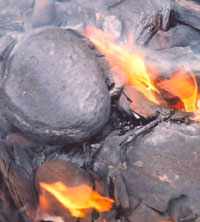
Photo from wikipedia
Abstract Detecting the oil bearing features of shallow sands is significant for the petroleum geological exploration of a desert reservoir. Current geological extraction theory techniques to determine the oil bearing… Click to show full abstract
Abstract Detecting the oil bearing features of shallow sands is significant for the petroleum geological exploration of a desert reservoir. Current geological extraction theory techniques to determine the oil bearing features of shallow sands are very limited because of the presence of very little organic matter. Here, a thermal terahertz (THz) analysis (TTA) method, which is sensitive to the difference of organic matter and minerals, is used to measure the pyrolysis products of sands collected from the shallow ground. The THz parameter reflects a 20.4% rate of change, which is much higher than the 2.3% rate of mass change during the pyrolysis stage of organic matter from ~300 °C to ~700 °C. Meanwhile, the collected trend directly indicates the turning point between organic matters pyrolysis and the mineral decomposition, which solves the difficulty in identifying them. Shallow sands contain limited water because of the small change of THz response in the range less than 300 °C. The organic matter then decomposes due to the continuous decrease of THz attenuation coefficient per unit thickness. In the high temperature range, minerals such as calcite would decompose. The results are validated by measuring the infrared spectra with a scanning electron microscope. Due to the considerable complexity of a desert reservoir, a high response like 20.4% of THz parameter change becomes necessary to identify the oil features. Because the THz waves are closely related to the pyrolysis products, the sensitive detection carried out with TTA can improve the prospecting efficiency of desert reservoir.
Journal Title: Journal of Petroleum Science and Engineering
Year Published: 2020
Link to full text (if available)
Share on Social Media: Sign Up to like & get
recommendations!